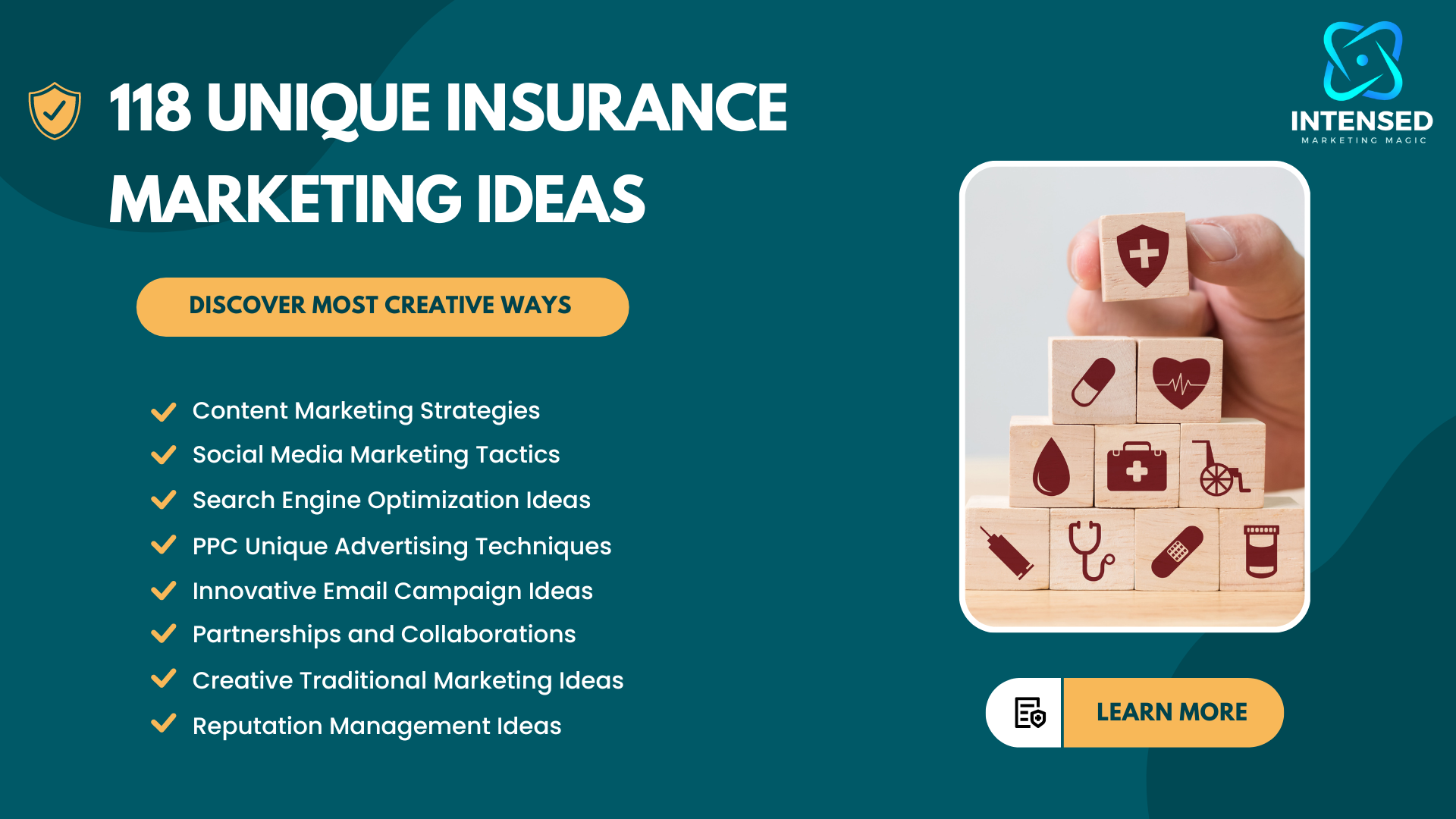In 2024, insurance marketing isn’t just about selling policies, it’s about forging connections. People want genuine advice and solutions that fit seamlessly into their lives. Think of yourself as a trusted guide rather than just a salesperson.
According to a recent study by Deloitte, 48% of insurance customers prefer to research and purchase policies online, highlighting the growing importance of digital marketing in the insurance industry. Furthermore, a survey by Accenture found that 74% of consumers are willing to share personal data with insurers in exchange for personalized services and discounts, emphasizing the need for data-driven marketing strategies.
This blog post reveals 118 highly effective and innovative insurance marketing ideas to help insurance agencies promote insurance products and services, generate more qualified leads, and drive sales growth. Whether you are looking for low-cost tactics or large-scale initiatives, you will discover actionable ideas to boost your insurance marketing results.
Whether you’re a seasoned insurance marketer looking to refresh your approach or an insurance agent seeking to grow your business, this guide will provide you with a wealth of actionable ideas and insights to help you stay ahead of the curve in the ever-changing insurance landscape. So, let’s dive in and discover the most effective ways to promote your insurance products and services, attract new leads, and build lasting relationships with your customers in 2024 and beyond.

- Content Marketing Strategies
- Social Media Marketing Tactics
- Search Engine Optimization (SEO)
- Pay-Per-Click (PPC) Advertising
- Email Marketing
- Community Building and Engagement
- Partnerships and Collaborations
- Traditional Marketing Tactics
- Referral Marketing
- Reputation Management
- Conclusion
- Frequently Asked Questions About Insurance Marketing Ideas
Content Marketing Strategies
Content marketing is one of the best ways for insurance agents to reach, engage, and convert target audiences online. By consistently creating and distributing valuable, relevant content, you can attract and retain more insurance customers.
Here are some powerful content marketing ideas to promote insurance products and grow your insurance business:
- Develop a multi-channel content marketing plan: Create a content strategy that encompasses various channels, such as your website blog, social media platforms, email newsletters, and video platforms. Ensure that your content is tailored to the specific needs and preferences of your target audience on each channel. We recommend This AI tool to help you in automating your content, and you can try it free.
- Create educational blog posts, videos, and infographics: Produce high-quality, informative content that addresses common questions, concerns, and pain points of your potential customers. For example, create blog posts that explain different types of insurance policies, their benefits, and how to choose the right coverage. Use engaging visuals, such as videos and infographics, to make complex insurance concepts more accessible and shareable.
- Offer valuable downloadable guides and whitepapers: Develop in-depth resources, such as e-books, whitepapers, and guides, that provide comprehensive information on specific insurance topics. For example, “The 10 Best Life Insurance Plans for Families”. Gate them behind opt-in forms to collect lead contact information. These resources can serve as lead magnets to attract potential customers and capture their contact information for future marketing efforts.
- Share client success stories and case studies: Showcase real-life examples of how your insurance products and services have helped clients overcome challenges and achieve their goals. These success stories can help build trust and credibility with your target audience and demonstrate the value of your offerings.
- Host webinars and virtual events: Organize online events, such as webinars, Q&A sessions, and workshops, to educate your audience about insurance topics and showcase your expertise. These events can also provide opportunities for interactive engagement and lead generation.
- Develop a content calendar aligned with business goals: Plan your content creation and distribution efforts in advance by creating a content calendar that aligns with your overall business objectives. This will help ensure that your content marketing efforts are consistent, targeted, and measurable.
- Repurpose content across multiple channels: Maximize the impact of your content by repurposing it across various channels. For example, turn a blog post into a video script, create social media posts highlighting key takeaways from a whitepaper, or use webinar recordings as the basis for a podcast episode.
- Collaborate with industry experts for guest blog posts: Partner with respected industry professionals, such as financial advisors, risk managers, or legal experts, to create guest blog posts for your website. This can help expand your content offerings, attract new audiences, and build relationships with influential figures in the insurance industry.
- Create interactive content: Engage your audience with interactive content formats, such as quizzes, assessments, and calculators. For example, create a “Find Your Perfect Insurance Policy” quiz that helps users identify their coverage needs based on their lifestyle and preferences.
- Use data and research to create compelling infographics: Leverage industry data, research findings, and statistics to create informative and visually appealing infographics. These shareable assets can help position your brand as a knowledgeable resource and attract backlinks from other websites.

Social Media Marketing Tactics
Social media platforms offer insurance agents and marketers a powerful way to connect with their target audience, build brand awareness, and drive engagement. Here are some effective social media marketing tactics to consider for your insurance business in 2024:
- Optimize social media profiles for SEO: Ensure that your social media profiles are optimized for search engines by including relevant keywords in your bio, profile name, and description. This can help improve your visibility in search results and make it easier for potential customers to find your business.
- Post engaging content regularly: Maintain a consistent posting schedule across your social media channels, sharing a mix of informative, entertaining, and promotional content. Use eye-catching visuals, such as images and videos, to grab your audience’s attention and encourage engagement.
- Interact with followers and join relevant conversations: Actively engage with your followers by responding to comments, messages, and mentions in a timely and professional manner. Join relevant conversations and online communities related to insurance topics to expand your reach and establish your brand as a knowledgeable resource.
- Run social media contests and giveaways: Host contests and giveaways on your social media channels to incentivize engagement and attract new followers. For example, run a photo contest where participants share their favorite safety tips for a chance to win a prize, such as a smart home security system or a discount on their insurance premium.
- Partner with influencers for sponsored content: Collaborate with influencers in the insurance, finance, or lifestyle niches to create sponsored content that promotes your brand and products. This can help expand your reach, build credibility, and tap into new audiences.
- Create short, entertaining videos for TikTok and Instagram Reels: Leverage the popularity of short-form video platforms like TikTok and Instagram Reels to create engaging, informative, and entertaining content that showcases your brand’s personality and expertise. For example, create a series of “Insurance Myth Busting” videos that debunk common misconceptions about insurance policies.
- Create a Facebook group for customers to ask questions and share experiences: Establish a dedicated Facebook group for your customers and prospects to foster a sense of community and provide a platform for peer-to-peer support. Encourage members to ask questions, share their experiences, and provide feedback on your products and services.
- Host Instagram takeovers with industry experts or influencers: Partner with respected industry professionals or influencers to host Instagram takeovers, where they share their insights, tips, and experiences related to insurance topics. This can help attract new followers, build credibility, and provide valuable content for your audience.
- Develop a LinkedIn content strategy to attract B2B clients: If your insurance business targets other businesses, develop a tailored content strategy for LinkedIn that focuses on thought leadership, industry insights, and case studies. Engage with relevant LinkedIn groups and participate in discussions to build relationships with potential clients.
- Participate in Twitter chats related to insurance topics: Join and actively participate in Twitter chats related to insurance, finance, and risk management topics. This can help expand your network, demonstrate your expertise, and attract new followers who are interested in your insights and offerings.
- Use social media advertising to target specific demographics: Leverage the targeting capabilities of social media advertising platforms, such as Facebook Ads and LinkedIn Ads, to reach specific demographics, interests, and behaviors that align with your ideal customer profile. This can help maximize the impact of your advertising budget and drive more qualified leads to your business.
Innovative Social Media Campaign Ideas
In addition to the tactics mentioned above, here are some innovative social media campaign ideas to help your insurance business stand out in 2024:
- Interactive quizzes to help recommend insurance plans: Create engaging, interactive quizzes on social media that help users identify their insurance needs and recommend suitable plans based on their responses. This can provide a personalized experience for your audience and generate valuable leads for your business.
- “Ask Me Anything” live Q&A sessions: Host regular live Q&A sessions on social media platforms, such as Facebook Live or Instagram Live, where your audience can ask questions and receive real-time answers from insurance experts. This can help build trust, demonstrate your expertise, and provide valuable insights for your followers.
- User-generated content campaigns: Encourage your customers to share their experiences, stories, and photos related to your insurance products and services. Create a branded hashtag and incentivize participation with prizes or features on your social media channels. This can help build a sense of community, increase brand loyalty, and provide authentic content for your marketing efforts.
- Charitable donation drives: Partner with a local charity or non-profit organization and launch a social media campaign that ties your insurance business to a good cause. For example, pledge to donate a portion of your proceeds from new policies to the charity, and encourage your followers to participate by sharing the campaign and tagging friends. This can help build goodwill, attract new customers, and make a positive impact in your community.

Search Engine Optimization (SEO)
Search engine optimization (SEO) is a crucial component of any effective digital marketing strategy for insurance businesses.
By optimizing your website and online content for search engines, you can improve your visibility in search results, attract more organic traffic, and generate high-quality leads for your business. Here are some essential SEO tactics to consider for your insurance agency marketing efforts in 2024:
- Conduct thorough keyword research: Use tools like Google Keyword Planner, SEMrush, or Ahrefs to identify the most relevant and high-traffic keywords related to your insurance products and services. Focus on long-tail keywords that are specific to your niche and have lower competition, as these can help you attract more targeted traffic to your website.
- Optimize website content for target keywords: Incorporate your target keywords naturally into your website’s content, including page titles, headings, meta descriptions, and body text. Ensure that your content is informative, engaging, and provides value to your target audience while also being optimized for search engines.
- Build high-quality backlinks: Develop a link-building strategy to acquire high-quality backlinks from reputable websites in the insurance, finance, and related industries. This can help improve your website’s authority and search engine rankings. Focus on creating valuable, shareable content that other websites will want to link to, such as industry reports, infographics, or expert interviews.
- Improve website speed and mobile-friendliness: Ensure that your website loads quickly and is optimized for mobile devices, as these factors can significantly impact your search engine rankings and user experience. Use tools like Google PageSpeed Insights to identify areas for improvement and implement recommendations to enhance your website’s performance.
- Implement schema markup: Add schema markup to your website’s code to provide search engines with more context about your content and help them display rich snippets in search results. This can help improve your click-through rates and attract more qualified traffic to your website. Use the Schema.org vocabulary to markup your insurance products, services, customer reviews, and other relevant information.
- Claim and optimize Google My Business listing: Create or claim your Google My Business (GMB) listing and ensure that all information, such as your business name, address, phone number, website, and hours of operation, is accurate and up-to-date. Encourage satisfied customers to leave reviews on your GMB listing, as this can help improve your local search visibility and build trust with potential customers.
- Create a comprehensive FAQ section on your website: Develop a detailed FAQ section that addresses common questions and concerns related to your insurance products and services. This can help improve your website’s relevance for long-tail keyword searches, provide valuable information for your audience, and potentially attract featured snippet placements in search results.
- Optimize meta titles and descriptions for click-through rates: Craft compelling meta titles and descriptions that accurately reflect your page content and entice users to click through from search results. Use action-oriented language, include your target keywords, and highlight the unique benefits of insurance products or your insurance offerings to improve your click-through rates and attract more qualified traffic.
- Implement a blog content strategy targeting long-tail keywords: Develop a comprehensive blog content strategy that targets long-tail keywords related to your insurance niche. Create in-depth, informative blog posts that address your target audience’s pain points, questions, and interests, while also incorporating relevant keywords and internal links to other pages on your website.
- Earn backlinks through guest posting and broken link building: Identify opportunities to contribute guest posts on reputable websites in the insurance and finance industries. Create high-quality, informative content that includes natural backlinks to your website. Additionally, use tools like SEMrush to identify broken links on relevant websites and reach out to the site owners, offering your content as a replacement.
- Monitor and analyze keyword rankings and organic traffic: Regularly monitor your website’s keyword rankings and organic traffic using tools like Google Search Console, or Ahrefs. Analyze your performance, identify areas for improvement, and adjust your SEO strategy accordingly to optimize your results over time.

Pay-Per-Click (PPC) Advertising
Pay-per-click (PPC) advertising is a powerful marketing tool for insurance agents and marketers to reach their target audience, drive targeted traffic to their websites, and generate high-quality leads.
By leveraging platforms like Google Ads, Microsoft Advertising, and social media advertising, you can create targeted campaigns that deliver your message to the right people at the right time. Here are some effective PPC advertising tactics to consider for your insurance marketing efforts in 2024:
- Launch Google Search Ads campaigns: Create targeted Google Search Ads campaigns that focus on high-intent keywords related to your insurance products and services. Use compelling ad copy that highlights your unique value proposition, and direct users to relevant landing pages optimized for conversions.
- Run display and remarketing ads: Utilize Google Display Network and other display advertising platforms to reach your target audience across a wide range of websites and apps. Implement remarketing campaigns to target users who have previously interacted with your website, as these individuals are more likely to convert into customers.
- Experiment with Google Local Services Ads: If your insurance business has a local focus, consider using Google Local Services Ads to reach potential customers in your area. These ads appear at the top of search results and allow users to directly contact your business, making it easier to generate qualified leads.
- Try Microsoft Advertising on Bing: While Google Ads is the most popular PPC platform, don’t overlook the potential of Microsoft Advertising on Bing. This platform can provide access to a unique audience and often offers lower costs-per-click compared to Google Ads.
- Explore paid social media advertising options: Leverage the targeting capabilities of social media advertising platforms, such as Facebook Ads, Instagram Ads, LinkedIn Ads, and Twitter Ads, to reach your ideal customer profile. Create engaging ad content that resonates with your target audience and drives them to take action.
- A/B test ad copy and landing pages for optimal performance: Continuously test and optimize your ad copy and landing pages to improve your PPC campaign performance. Use A/B testing to compare different versions of your ads and landing pages, and identify the elements that drive the best results in terms of click-through rates, conversion rates, and cost-per-acquisition.
- Use ad extensions to provide additional information and CTAs: Maximize the impact of your PPC ads by using ad extensions, such as sitelinks, callouts, and structured snippets. These extensions provide additional information about your insurance offerings and give users more opportunities to engage with your business.
- Implement conversion tracking to measure ROI: Set up conversion tracking for your PPC campaigns to accurately measure the return on investment (ROI) of your advertising efforts. This will help you identify the campaigns, ad groups, and keywords that drive the most valuable conversions, such as form submissions or phone calls, allowing you to optimize your marketing budget allocation accordingly.
- Experiment with video ads on YouTube and other platforms: Create engaging video ads that showcase your insurance products, services, and brand personality. Use platforms like YouTube, Facebook, and Instagram to reach your target audience with video content that educates, entertains, and inspires them to take action.
- Optimize campaigns for mobile devices: With the increasing prevalence of mobile devices, it’s crucial to ensure that your PPC campaigns are optimized for mobile users. Create mobile-friendly ad copy and landing pages, and consider using mobile-specific ad formats, such as click-to-call ads, to make it easier for users to engage with your business on their smartphones.
Creative PPC Ad Ideas
In addition to the tactics mentioned above, here are some creative PPC ad ideas to help your insurance business stand out and attract more qualified leads:
- Highlight unique selling propositions in ad copy: Use your ad copy to emphasize the unique benefits and features of your insurance offerings that set you apart from competitors. This could include customizable coverage options, exceptional customer service, or specialized expertise in a particular niche.
- Use emotional triggers and storytelling: Craft ad copy that taps into the emotions and pain points of your target audience. Use storytelling techniques to create a connection with potential customers and demonstrate how your insurance products can provide peace of mind, security, and protection for their loved ones and assets.
- Offer exclusive discounts or promotions: Entice potential customers to click on your ads by offering exclusive discounts, promotions, or bundled services. This could include a percentage off their first year’s premium, a free insurance review, or additional coverage options at no extra cost.
- Create compelling lead magnets: Develop valuable lead magnets, such as e-books, whitepapers, or webinars, that address the needs and interests of your target audience. Use your PPC ads to promote these lead magnets and capture user information, allowing you to nurture these leads through email marketing and other channels.

Email Marketing
Email marketing is a great effective way for insurance agents and marketers to nurture leads, build relationships with customers, and drive conversions.
By creating targeted, personalized email campaigns, you can keep your audience engaged, informed, and motivated to take action. Here are some email marketing strategies to consider for your insurance business in 2024:
- Segment email lists for personalization: Divide your email subscribers into specific segments based on factors such as demographics, interests, policy types, or stage in the customer journey. This allows you to create more personalized and relevant email content that resonates with each segment, improving engagement and conversion rates.
- Automate lead nurturing email sequences: Develop automated email sequences that nurture leads through the sales funnel. This could include a welcome series for new subscribers, educational content about insurance topics, case studies showcasing customer success stories, and promotional offers tailored to each lead’s interests and needs.
- Send monthly newsletters with valuable content: Create a monthly email newsletter that provides your subscribers with valuable, informative content related to insurance, financial planning, and risk management. Include a mix of blog posts, industry news, tips, and resources to keep your audience engaged and position your business as a trusted authority in the field.
- Offer exclusive perks to email subscribers: Incentivize email subscriptions by offering exclusive perks, such as discounts, free resources, or early access to new insurance products or services. This can help grow your email list and foster loyalty among your subscribers.
- Test email subject lines and calls-to-action: Continuously test and optimize your email subject lines and calls-to-action (CTAs) to improve open rates, click-through rates, and conversions. Use A/B testing to compare different versions of your subject lines and CTAs, and identify the elements that drive the best results.
- Create a welcome email series for new subscribers: Develop a welcome email series that introduces new subscribers to your insurance business, sets expectations for future communications, and provides valuable resources or offers. This can help build trust, establish a positive relationship, and encourage engagement from the start.
- Develop targeted email campaigns based on customer segments: Create targeted email campaigns that address the specific needs, interests, and challenges of each customer segment. For example, send personalized policy renewal reminders, cross-sell or upsell relevant insurance products, or provide tailored risk management advice based on a customer’s unique situation.
- Use email to promote blog content and resources: Leverage email marketing to drive traffic to your website’s blog content, whitepapers, e-books, and other valuable resources. Include compelling previews or excerpts in your emails, along with clear CTAs that encourage subscribers to click through and engage with your content.
- Test email send times and frequencies for optimal engagement: Experiment with different email send times and frequencies to determine what works best for your audience. Use analytics to track open rates, click-through rates, and conversions, and adjust your email marketing strategy accordingly to optimize engagement and minimize unsubscribes.
- Implement email list hygiene practices to maintain deliverability: Regularly clean your email list by removing inactive or invalid email addresses, and ensure that your email content and sending practices comply with anti-spam regulations. This can help maintain high deliverability rates and protect your sender reputation.
Innovative Email Campaign Concepts
In addition to the strategies mentioned above, here are some innovative email campaign concepts to help your insurance business stand out in the inbox and drive more engagement:
- Personalized insurance recommendation quizzes: Create interactive email quizzes that help subscribers identify their insurance needs and recommend tailored coverage options based on their responses. This can provide a more engaging and personalized experience that drives conversions and customer loyalty.
- Interactive scrollable emails: Design email templates that feature interactive, scrollable elements, such as product carousels, accordions, or parallax effects. This can make your emails more visually appealing, engaging, and memorable, encouraging subscribers to explore your insurance offerings in a more immersive way.
- Animated GIF product demos: Use animated GIFs in your emails to showcase your insurance products or services in action. This could include demonstrations of how to use your online policy management portal, or visualizations of how your coverage options protect customers in different scenarios.
- Referral reward programs: Implement a referral reward program that incentivizes email subscribers to refer their friends, family, or colleagues to your insurance business. Offer exclusive discounts, gift cards, or other rewards for successful referrals, and use email marketing to promote the program and celebrate top referrers.

Community Building and Engagement
Building a strong, engaged community around your insurance brand is essential for fostering customer loyalty, generating word-of-mouth referrals, and establishing your business as a trusted authority in the industry. By creating opportunities for customers to interact with your brand and each other, you can create a sense of belonging and value that goes beyond traditional insurance transactions.
Here are some community building and engagement strategies to consider for your insurance business in 2024:
- Encourage customer reviews and testimonials: Actively seek out customer reviews and testimonials, and showcase them on your website, social media channels, and marketing materials. Positive reviews and testimonials can help build trust and credibility with potential customers, while also providing valuable feedback for improving your products and services.
- Engage in local community events and sponsorships: Participate in local community events, such as charity fundraisers, sports tournaments, or festivals, and consider sponsoring events that align with your brand values and target audience. This can help increase your brand visibility, generate goodwill, and create opportunities for personal interactions with potential customers.
- Launch a customer loyalty or rewards program: Develop a loyalty or rewards program that incentivizes customers to continue doing business with your insurance company. This could include perks such as premium discounts, gift cards, or exclusive access to events or resources based on their length of membership or total policy value.
- Create a private Facebook group for customers: Establish a private Facebook group exclusively for your insurance customers, where they can ask questions, share experiences, and engage with your team in a more informal setting. This can help build a sense of community, provide valuable insights into customer needs and preferences, and create opportunities for upselling and cross-selling.
- Host customer appreciation events: Organize special events, such as webinars, workshops, or social gatherings, to show appreciation for your customers and provide them with valuable information or entertainment. This can help strengthen customer relationships, generate positive word-of-mouth, and create a more memorable and engaging brand experience.
- Create a user-generated content campaign: Encourage customers to share their stories, photos, or videos related to your insurance products or services, and showcase this user-generated content across your marketing channels. This can help build authenticity, trust, and engagement, while also providing valuable social proof for potential customers.
- Launch a scholarship program for local students: Create a scholarship program that supports local students pursuing degrees related to insurance, finance, or risk management. This can help demonstrate your commitment to education and community development, while also building relationships with potential future customers and employees.
- Sponsor a community garden or park cleanup initiative: Partner with local organizations to sponsor a community garden or park cleanup initiative, and encourage your customers and employees to volunteer and participate. This can help demonstrate your commitment to environmental sustainability and community well-being, while also creating opportunities for team building and customer engagement.
- Host a virtual or in-person networking event for customers: Organize a networking event, either virtually or in-person, where your insurance customers can connect with each other, share insights and experiences, and learn from industry experts. This can help foster a sense of community, provide valuable professional development opportunities, and create a more engaging and valuable customer experience.
- Develop a customer advisory board for feedback and insights: Invite a select group of loyal customers to join a customer advisory board, where they can provide feedback, insights, and suggestions for improving your insurance products, services, and customer experience. This can help you stay attuned to customer needs and preferences, while also creating a sense of exclusivity and value for your most engaged customers.

Partnerships and Collaborations
Forming strategic partnerships and collaborations with other businesses, organizations, and influencers can help insurance agents and marketers expand their reach, tap into new customer segments, and create more value for their existing customers.
By leveraging the strengths and resources of partners, you can create more comprehensive and compelling insurance offerings, while also reducing marketing costs and risks. Here are some partnership and collaboration ideas to consider for your insurance business in 2024:
- Partner with local businesses for cross-promotions: Identify local businesses that serve similar target audiences or offer complementary products or services, such as real estate agencies, financial advisors, or auto insurance dealerships. Develop cross-promotional campaigns that offer bundled discounts, referral incentives, or co-branded marketing materials to customers who purchase from both businesses.
- Collaborate with non-competing insurance providers: Partner with insurance providers that offer different types of coverage, such as health insurance or life insurance, to create more comprehensive and convenient insurance packages for customers. This can help you expand your product offerings, reach new customer segments, and create more value for existing customers.
- Sponsor relevant podcasts or YouTube channels: Identify popular podcasts or YouTube channels that cover topics related to insurance, finance, or risk management, and sponsor episodes or series that align with your brand values and target audience. This can help you reach new audiences, build credibility, and create more engaging and informative content for your customers.
- Participate in industry associations and events: Join relevant industry associations, such as the Independent Insurance Agents & Brokers of America (IIABA) or the National Association of Insurance and Financial Advisors (NAIFA), and actively participate in their events, committees, and initiatives. This can help you stay informed about industry trends, build relationships with potential partners and customers, and create opportunities for collaboration and growth.
- Establish affiliate marketing partnerships: Develop an affiliate marketing program that incentivizes bloggers, influencers, or other businesses to promote your insurance products or services to their audiences. Offer competitive commission rates, marketing resources, and support to help your affiliates succeed, and track the performance of your program to optimize results over time.
- Co-host webinars or events with complementary businesses: Partner with businesses that offer complementary products or services, such as financial planning or legal services, to co-host webinars, workshops, or other events that provide valuable information and resources to your shared target audiences. This can help you expand your reach, build credibility, and create more engaging and valuable content for your customers.
- Develop joint marketing campaigns with partners: Collaborate with partners to develop joint marketing campaigns that leverage your combined resources, expertise, and customer bases. This could include co-branded social media campaigns, email marketing initiatives, or content marketing projects that create more comprehensive and compelling insurance offerings for your shared target audiences.
- Create co-branded content with partners: Partner with businesses or influencers to create co-branded blog posts, videos, podcasts, or other content that educates and engages your shared target audiences. This can help you expand your content offerings, reach new audiences, and build credibility and trust with potential customers.
- Offer bundled services or discounts with partners: Collaborate with partners to offer bundled services or discounts that provide more value and convenience for your shared customers. For example, partner with a home security company to offer discounted home insurance rates for customers who install qualifying security systems, or partner with a travel agency to offer bundled travel insurance and trip planning services.
- Establish strategic partnerships with local organizations: Form strategic partnerships with local organizations, such as chambers of commerce, professional associations, or community groups, to create more opportunities for networking, referrals, and community engagement. This can help you build relationships with potential partners and customers, while also demonstrating your commitment to local economic development and social responsibility.

Traditional Marketing Tactics
While digital marketing has become increasingly important for insurance businesses, traditional marketing tactics can still play a valuable role in reaching and engaging target audiences.
By combining traditional and digital marketing strategies, insurance agents and marketers can create more comprehensive and effective campaigns that drive brand awareness, generate leads, and build customer loyalty. Here are some traditional marketing tactics to consider for your insurance business in 2024:
- Direct mail campaigns with personalized offers: Develop targeted direct mail campaigns that deliver personalized insurance offers, discounts, or resources to specific customer segments based on their demographics, interests, or behaviors. Use compelling copy, visuals, and calls-to-action to encourage recipients to respond and engage with your brand.
- Outdoor advertising (billboards, bus stops, etc.): Invest in outdoor advertising, such as billboards, bus stop ads, or bench ads, to increase brand visibility and reach potential customers in high-traffic areas. Use eye-catching visuals, memorable slogans, and clear calls-to-action to encourage viewers to learn more about your insurance offerings.
- Radio and television advertising: Create radio or television ads that showcase your insurance products, services, and brand personality to a broad audience. Use compelling storytelling, humor, or emotional appeals to capture viewers’ attention and encourage them to take action, such as visiting your website or contacting your office.
- Print ads in local newspapers and magazines: Place print ads in local newspapers, magazines, or other publications that reach your target audience. Use engaging headlines, visuals, and copy to highlight your unique value proposition and encourage readers to learn more about your insurance offerings.
- Branded promotional products and giveaways: Invest in branded promotional products, such as pens, notepads, or stress balls, and distribute them at local events, trade shows, or customer meetings. These items can help increase brand visibility, create a positive association with your business, and encourage recipients to keep your contact information on hand.
- Sponsor local sports teams or community events: Sponsor local sports teams, charity events, or community festivals to increase brand visibility, generate goodwill, and create opportunities for personal interactions with potential customers. Use branded signage, uniforms, or giveaways to maximize your exposure and encourage attendees to learn more about your insurance offerings.
- Participate in trade shows and conferences: Attend relevant trade shows and conferences to showcase your insurance products, services, and expertise to a targeted audience of potential customers and partners. Use engaging booth displays, demonstrations, and collateral to capture attendees’ attention and encourage them to learn more about your business.
- Host educational seminars or workshops: Organize educational seminars or workshops that provide valuable information and resources to your target audience, such as tips for managing risk, understanding insurance policies, or planning for retirement. Use these events to establish your expertise, build relationships with potential customers, and generate leads for your business.
- Distribute flyers and brochures in high-traffic areas: Create informative flyers and brochures that highlight your insurance offerings, and distribute them in high-traffic areas, such as shopping centers, office buildings, or community centers. Use compelling headlines, visuals, and calls-to-action to encourage recipients to learn more and contact your business.
- Create eye-catching window displays in local offices: Design eye-catching window displays or signage for your local insurance offices that showcase your products, services, and brand personality. Use engaging visuals, messaging, and calls-to-action to encourage passersby to stop in and learn more about your business.
Creative Traditional Marketing Ideas
In addition to the tactics mentioned above, here are some creative traditional marketing ideas to help your insurance business stand out and engage potential customers:
- Interactive direct mail pieces: Create direct mail pieces that include interactive elements, such as scratch-off discounts, pop-up displays, or personalized URLs, to encourage recipients to engage with your brand and take action.
- Geo-targeted mobile billboards: Use geo-targeted mobile billboards that display personalized insurance offers or messages based on the location and demographics of nearby consumers. This can help you reach a more targeted and relevant audience with your outdoor advertising efforts.
- Sponsored local weather forecasts: Partner with local TV or radio stations to sponsor weather forecasts or traffic reports, and include brief mentions or ads for your insurance business. This can help you reach a broad and attentive audience during a time when they are likely to be receptive to your message.
- Branded reusable shopping bags: Distribute branded reusable shopping bags at local grocery stores, farmers markets, or community events. These bags can help increase brand visibility and create a positive association with your business, while also encouraging recipients to use them repeatedly and share your brand with others.

Referral Marketing
Referral marketing is a powerful strategy for insurance businesses to leverage the trust and influence of existing customers to attract new ones.
By incentivizing and encouraging customers to refer their friends, family, or colleagues to your business, you can generate high-quality leads, reduce customer acquisition costs, and create a more loyal and engaged customer base. Here are some referral marketing tactics to consider for your insurance business in 2024:
- Create a referral incentive program: Develop a referral incentive program that rewards customers for successfully referring new business to your insurance company. Offer incentives such as premium discounts, gift cards, or cash bonuses for each referral that results in a new policy or customer.
- Encourage social media followers to refer friends: Leverage your social media presence to encourage followers to refer their friends and family to your insurance business. Create social media posts, stories, or ads that highlight your referral program and incentives, and make it easy for followers to share your content or referral links with their networks.
- Offer tiered rewards for successful referrals: Implement a tiered rewards system that offers increasing incentives for customers who refer multiple new customers or policies to your business. This can help encourage customers to become more active and engaged referral partners, and create a sense of competition and achievement among your referral base.
- Partner with local businesses for referral exchanges: Identify local businesses that serve similar target audiences or offer complementary products or services, and establish referral exchange partnerships. Agree to refer customers to each other’s businesses when appropriate, and track the performance of your referral exchanges to ensure mutual benefit and accountability.
- Launch an affiliate program for referral partners: Develop an affiliate program that allows referral partners, such as bloggers, influencers, or other businesses, to earn commissions or rewards for promoting your insurance products or services to their audiences. Provide affiliates with unique referral links, marketing resources, and support to help them succeed, and track the performance of your program to optimize results over time.
- Create shareable referral links for customers: Provide customers with unique referral links that they can easily share with their friends, family, or social media followers. These links should track referrals back to the original customer, and automatically apply any referral incentives or discounts to the new customer’s policy or account.
- Offer a “refer a friend” discount or incentive: Create a “refer a friend” discount or incentive that provides both the referring customer and the new customer with a special offer or benefit, such as a premium discount or a free add-on service. This can help encourage customers to refer their friends and family, while also creating a positive first impression for new customers.
- Launch a social media contest for the most referrals: Run a social media contest that challenges customers to refer the most new business to your insurance company within a specific timeframe. Offer valuable prizes or experiences for the top referrers, and encourage participants to share their progress and success stories on social media to generate buzz and engagement.
- Provide referral partners with marketing materials and support: Equip your referral partners with a range of marketing materials and resources, such as email templates, social media graphics, or brochures, to help them effectively promote your insurance products or services to their audiences. Offer ongoing support, training, and communication to help partners succeed and feel valued.
- Recognize and reward top referrers publicly: Celebrate and recognize your top referral partners or customers through public channels, such as your website, social media, or email newsletters. Share their success stories, testimonials, or photos to showcase their achievements and inspire others to participate in your referral program.

Reputation Management
In today’s digital age, managing your insurance business’s online reputation is crucial for attracting and retaining customers, building trust and credibility, and standing out from competitors.
By actively monitoring and responding to customer reviews, feedback, and mentions across various online platforms, you can proactively shape your brand’s image, address potential issues or concerns, and create a more positive and engaging customer experience. Here are some reputation management strategies to consider for your insurance business in 2024:
- Monitor and respond to online reviews: Regularly monitor popular review sites, such as Google My Business, Yelp, or industry-specific platforms, for new reviews or ratings of your insurance business. Respond promptly and professionally to all reviews, both positive and negative, to show that you value customer feedback and are committed to addressing any issues or concerns.
- Encourage satisfied customers to leave reviews: Proactively ask satisfied customers to leave reviews or ratings of your insurance business on popular review sites or social media platforms. Provide links or instructions to make the process easy and convenient, and consider offering incentives, such as a small discount or a chance to win a prize, for customers who leave a review.
- Address negative feedback promptly and professionally: When responding to negative reviews or feedback, acknowledge the customer’s concerns, apologize for any inconvenience or dissatisfaction, and offer to resolve the issue offline or through private communication channels. Avoid getting defensive or argumentative, and focus on finding a mutually beneficial solution that demonstrates your commitment to customer service.
- Share positive reviews on social media and website: Highlight positive reviews, testimonials, or ratings on your social media profiles, website, or marketing materials to showcase your satisfied customers and build trust and credibility with potential customers. Use engaging visuals, such as customer photos or videos, to make these testimonials more authentic and impactful.
- Implement a reputation management software solution: Invest in a reputation management software solution, such as Birdeye, Reputation.com, or Podium, to streamline and automate your online reputation monitoring, reporting, and response processes. These tools can help you track your business’s performance across multiple review sites, generate custom reports and alerts, and respond to reviews or messages from a centralized dashboard.
- Create a system for regularly requesting customer reviews: Develop a systematic process for requesting customer reviews or feedback at key touchpoints in the customer journey, such as after a policy purchase, a claim settlement, or an anniversary date. Use automated email or text message campaigns, in-person requests, or physical comment cards to make the process easy and consistent.
- Respond to all reviews, both positive and negative: Make a commitment to respond to all customer reviews or ratings, regardless of whether they are positive or negative. For positive reviews, express your gratitude and appreciation for the customer’s feedback and loyalty. For negative reviews, follow the guidelines mentioned earlier to address the issue and demonstrate your commitment to customer satisfaction.
- Share customer success stories and testimonials on your website: Create a dedicated section on your website for customer success stories, case studies, or video testimonials that showcase how your insurance products or services have helped customers protect their assets, achieve their goals, or overcome challenges. Use compelling storytelling and visuals to make these testimonials more engaging and persuasive.
- Monitor mentions of your brand on social media and online forums: Use social media monitoring tools, such as Hootsuite, Sprout Social, or Mention, to track mentions of your insurance brand, products, or services across various social media platforms and online forums. Respond promptly and professionally to any questions, concerns, or feedback, and use these interactions to build relationships and gather valuable customer insights.
- Develop a crisis communication plan for potential PR issues: Create a crisis communication plan that outlines how your insurance business will respond to potential public relations issues or negative publicity, such as a data breach, a lawsuit, or a controversial social media post. Identify key stakeholders, communication channels, and messaging strategies to ensure a prompt, transparent, and effective response that minimizes damage to your brand’s reputation.

Conclusion
In this blog post, we’ve explored a wide range of innovative and creative insurance marketing ideas for 2024, covering various strategies and tactics across content marketing, social media, SEO, PPC advertising, email campaigns, community building, partnerships, traditional marketing, referral programs, and reputation management.
Remember these critical takeaways:
- Stay innovative: Don’t be afraid to try new marketing strategies, technologies, and creative campaigns. The digital world changes fast!
- Adapt to changing trends: Pay attention to emerging social platforms, consumer behaviors, and new forms of insurance to find opportunities for your business.
- Encourage experimentation: Give yourself permission to test different approaches. Analyze the results and double down on what works for your specific agency.
- Prioritize customer experience: In a world of online comparison shopping, outstanding customer service is how you truly stand out from the competition.
Think of this blog post as your launchpad for 2024 and beyond! Pick a few strategies that resonate most with your ideal audience and start implementing them with consistency and enthusiasm.
It’s crucial for insurance agents and marketers to stay ahead of the curve and embrace new and innovative approaches to attract, engage, and retain customers.
However, it’s important to remember that not all marketing ideas will be equally effective or relevant for every insurance business. The key is to experiment with different strategies, continually monitor and analyze performance data, gather customer feedback, and adapt your approaches based on what works best for your unique target audience, products, services, and goals.
As an experienced digital marketer, I encourage insurance agents and marketers to stay curious, creative, and agile in their marketing efforts. Don’t be afraid to try new ideas, test unconventional approaches, and learn from both success of your marketing efforts and failures. By embracing a growth mindset and a customer-first philosophy, you can position your insurance business for long-term success and resilience in the face of industry challenges and disruptions.
So, whether you’re a seasoned insurance marketer looking to refresh your strategies or an agent just starting to explore new ways to grow your business, I hope this blog post has provided you with valuable insights, inspiration, and actionable ideas to take your insurance marketing to the next level in 2024 and beyond.
If you found this content helpful, informative, or thought-provoking, I invite you to share it with your colleagues, partners, and professional networks. Let’s work together as an industry to innovate, collaborate, and deliver exceptional value to our customers and communities.
Thank you for reading, and I wish you all the best in your insurance marketing endeavors!
Frequently Asked Questions About Insurance Marketing Ideas
What are the best marketing ideas for insurance agents in 2024?
The best insurance marketing ideas for 2024 include content marketing, social media engagement, SEO optimization, PPC advertising, email campaigns, community building, strategic partnerships, traditional marketing tactics, referral programs, and reputation management.
How can I market my insurance business effectively?
To market your insurance business effectively, develop a comprehensive strategy that combines digital and traditional tactics. Focus on creating valuable content, engaging on social media, optimizing for search engines, running targeted ads, nurturing leads via email, building community, forming partnerships, and managing your online reputation.
What are some innovative insurance marketing strategies?
Innovative insurance marketing strategies include interactive content (quizzes, calculators), personalized video marketing, influencer collaborations, live Q&A sessions, user-generated content campaigns, virtual events, chatbot assistance, and gamification techniques to educate and engage prospects.
How do I attract new clients to my insurance agency?
To attract new clients, optimize your website for search engines, create valuable content, leverage social media advertising, host educational webinars, attend community events, partner with local businesses, offer referral incentives, and showcase customer testimonials and success stories.
What are the most effective insurance lead generation techniques?
Effective insurance lead generation techniques include content marketing (blogs, ebooks, infographics), SEO, PPC advertising, social media marketing, email campaigns, referral programs, partnerships with complementary businesses, educational events, and online tools like coverage calculators and quote request forms.
How can I improve my insurance agency’s online presence?
To improve your agency’s online presence, create a user-friendly website, optimize for search engines, regularly publish valuable content, maintain active social media profiles, engage with your audience, list your business on online directories, manage your online reputation, and run targeted digital advertising campaigns.
What are some creative ways to promote my insurance products?
Creative ways to promote insurance products include interactive quizzes, personalized video content, social media contests, influencer partnerships, educational webinars, community events, charitable initiatives, customer loyalty programs, and bundled offerings with complementary services.
How do I build trust and credibility with potential insurance clients?
Build trust and credibility by showcasing your expertise through valuable content, highlighting customer testimonials and success stories, maintaining a professional online presence, promptly addressing customer inquiries and concerns, partnering with reputable businesses, and actively engaging with your community.
What are the most important insurance marketing metrics to track?
Key insurance marketing metrics include website traffic, lead generation, conversion rates, customer acquisition costs, retention rates, customer lifetime value, net promoter score, social media engagement, email open and click-through rates, and return on marketing investment.
How can I measure the success of my insurance marketing campaigns?
To measure the success of your insurance marketing campaigns, define clear goals and KPIs, track relevant metrics (leads, conversions, revenue), use analytics tools to monitor website and social media performance, conduct surveys to gather customer feedback, and calculate return on investment for each marketing channel.
